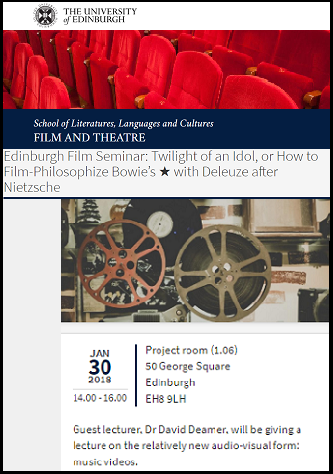‘Twilight of an Idol, or How to Film-Philosophize Bowie’s “★” with Deleuze after Nietzsche’

Edinburgh Film Seminar (2018).
Visiting Speaker Seminar.
School of Literatures, Languages and Cultures, University of Edinburgh, 30 January 2018.
Host: David Sorfa (University of Edinburgh).
Gilles Deleuze – fresh from his Cinema books – made some passing observations on a relatively new audio-visual form: music videos. ‘For a moment they bordered on something connected with thought’ and ‘could have become a really interesting new field of cinematic activity’, but were ‘immediately… taken over by marketing jingles’ and ‘organized mindlessness’ (Negotiations: 149; 60; 79). Given their minor status, as well as Deleuze’s critique, it is not at all strange that music videos are one of the least explored areas in cinema studies and Deleuzian film-philosophy. Nonetheless, I want to argue that some are as essential and exciting as any great movie, audio-visual art installation, documentary or tv series. Accordingly, the music videos of David Bowie – a pioneer in the form – can be explored using Deleuze’s cinematic semiosis (cineosis): the vital coalescence and ungrounding of audio-visual images through the play of the multiplicity of filmic signs.
Bowie, in this way, parallels Deleuze – and Deleuze parallels Bowie: and each can be made to resonate with the other – I claim – by way of Friedrich Nietzsche. Nietzsche writes in and of a ‘style’ of composition that creates a ‘mosaic’ of ‘signs’, creating a ‘force’ which ‘flows out… achieving a maximal semiotic energy’ (Twilight, ‘Ancients’: 1). Nietzsche’s style influences Deleuze’s philosophy and cineosis, as well as Bowie’s oeuvre and music videos. These videos are ever inventive, exploring new cinematic techniques and ideas concomitant with Bowie’s ongoing re-inventions into diverse personas by way of radical shifts in his music styles. Nietzsche affirms ‘multiplicity’, ‘change’, and ‘becoming’ over ‘unity, identity, [and] permanence’ (Twilight, ‘Reason’: 1;5). And with Bowie nowhere is there such a maximal cineotic energy than in ‘★’ (Johan Renck, 2016).
Seminar website | No transcript available as yet